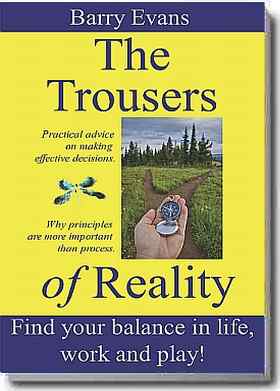An Interview with Barry Evans, author of “The Trousers Of Reality, volume 1″
Barry Evans works as an independent consultant and writer, and is based in France and the UK. I met Barry a few years ago at Agile Open in Belgium, when he was working as a senior coach in BT’s large-scale Agile introduction. Now we’ve done an interview to find out more about his new book “The Trousers of Reality”.
Willem: So Barry, When did you start thinking about writing a book?
Barry: I have always been a writer. I come from a literary family and it was always something I wanted to do..
Willem: what triggered you to write this one?
Barry: I started writing this book when I realised I had something to say and I had enough life experience behind me.
Willem: what experiences in particular inspired you?
Willem: ok, so your book helps to integrate home and work life?
Barry: Very much so. I maintain that the skills from either “life” can be used in the other; and if allowed to flow will improve both sides.
Willem: I’ve certainly experienced that, and I’ve also (to my surprise at first) seen this in clients I coached in their work – they started using techniques like planning with index cards with their partners.
Barry: For instance I have worked for years as an agile coach and I realised that many of the people I worked with were being branded as geeks but in fact were interesting people with many valuable personal skills that they should be encouraged to bring into the work place. This categorising and separation of people according to job tends to lose a lot that would be valuable to the employer and which would allow individuals to feel more at one with what they do.
As you point out the traffic is two way. It is my strongly held opinion that human beings are holistic and that there are serious consequences when we try to create Chinese walls in our own head.
Willem: In your book, you discuss a number of techniques, besides Agile also NLP, Systems Thinking and the Theory of Constraints. How do they help to improve business and private life?
Barry: I talk about things like NLP because it allows us to communicate better – this is useful everywhere.
NLP in particular concentrates on seeing the other persons point of view – it is not hard to see how this skill is useful talking to both your colleagues and your significant other.
Willem: indeed.
Barry: As you get good at it in one situation you must get better at it in all others – it is a skill that takes constant practice.
Willem: like playing the piano, programming, or writing….
Barry: Funny you should mention that – I use almost the same example in the book.
Willem: I swear I haven’t read it yet:). I’ve just been thinking a lot about deliberate practice recently.
Barry: When I looked at Agile and my experience as an Agile coach I realised that what Agile was doing most was clearing the lines of communication and trying to get rid of presuppositions on every side.
Willem: so that fits nicely with NLP then.
Barry: NLP is concerned with just that and has proven tools, so I said to myself – why reinvent the wheel.
Willem: that makes sense.
Barry: It also fits into systems thinking which shows how things are interrelated. You need to be able to see outside your job, categorisation, sphere of influence, interest, skill-set though.
Willem: yes, and that is a hard soft skill to master.
Barry: When I started looking at these things I noticed that they all had an intersection point and that interested me greatly.
Rather than the ceremony of Agile I started to ask myself why does it work and isn’t it interesting that other things that work all seem to intersect at a subset like a huge Venn diagram. In this intersection I started to find things that worked everywhere – therefore back to the work/life thing.
In fact that started to be my litmus test. The things with real value tend to work across borders of every kind or they are parlour tricks with limited shelf life.
Willem: so how do you distinguish one from the other?
Barry: In my experience with Agile and software development I began to realise that too much was being hung on which tribe you belonged to. Tribalism is the great enemy. My mission with the book is to tell people that whatever tribe you think you belong to that there are things that just work and it is power to understand why they work.
Just clinging to a tribe will leave you out in the cold sooner or later – it blinds you to what is really happening.
Ritual and ceremony were the target of Agile and they seem to have crept in under the door again – I want to call it before it is too late. Indeed NLP has the same problems and the same solutions. Understand the principles and why you are doing what you are doing…. If you really understand it you can turn it into a process for convenience; but you must know when and how to change that process.
Willem: how do you distinguish people who follow “the rules” by rote from those who genuinely want continuous improvement?
Barry: Well the quick answer is experience. It is also trust. If you are a business you hire people who genuinely know what they are doing and who are not afraid to tell you home truths. There is no lazy way out.
There are thought leaders and professionals who are clearly interested in making things work. Identify them. It is also important to develop your own ability to distinguish – based on experience and knowledge. I say in the book to beware the “One Truthers”. Look for flexibility and things that work in variety of environments. Be suspicious of spin and hyperbolic claims. In the end it comes down to Einstein’s advice – Everything should be made as simple as possible, but not simpler. Whereas Occam’s tool was a razor – Einstein uses a vice to similar effect.
Willem: The one topic you cover in the book that we haven’t discussed so far is the Theory of Constraints. How does that fit into all this?.
Barry: There is a chapter in the book called “The Key”. It explains what these things are and ties them together. Essentially TOC allows you to examine cause and effect and is a tool to work your way out of assumptions and constraints.It is great for helping you to understand your current reality so you can start to step up into systems thinking.
Willem: what have you learned from writing the book?
Barry: That writing books is great fun and marketing is hard work. Of course I did a lot of research and as I said in the book the real secret to life is to keep learning. It opens possibilities and opportunities. This is the great thing about what we do if we are involved in IT – we keep pushing our own boundaries of knowledge and what we think is possible.
Willem: yes, that is what got me into IT in the first place. Marketing folks would say that marketing is fun and writing a book is hard work, though ![]() .
.
Barry: Part of the secret of managing people is realising that what you like to do, or do not like to do, does not necessarily map onto other people. You must have empathy but at the same time realise the others feel differently to you. It makes it fun to work with people you do not understand, when you see that lack of understanding as a new model of the world to learn about. And you can be delighted that there is always someone out there you can work with who will like to do the things you do not – great teams are made of this sort of interaction.
You can find out more about Barry Evans and this book at The Trousers of Reality‘s website.



September 4th, 2009 at 3:15 pm
What a great interview. Lots of thought provoking stuff there. Especially like the bit about how all these different theories and techniques intersect.